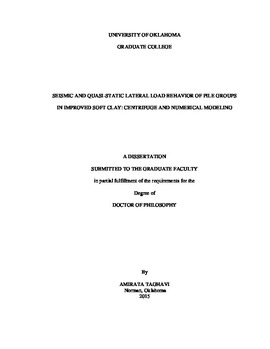| dc.description.abstract | In the design of pile foundations subjected to lateral loading, one of the objectives is to restrict the lateral displacements. Improving the soil surrounding the pile foundation is an innovative and cost-efficient solution to increase lateral resistance and restrict lateral displacements. This technique is, however, not widely used due to lack of fundamental understanding of the behavior of pile groups in improved weak soils. Due to the dearth of experimental data and lack of thorough understanding of their behavior, engineers are forced to design pile groups in improved soft clay in a conservative manner to mitigate the uncertainties.
To increase our understanding of the behavior of pile groups in improved and unimproved soft clays subjected to seismic and quasi-static lateral loads, two centrifuge models consisting of several pile groups were constructed and tested. The soil profile consisted of four lightly overconsolidated clay layers overlying a dense layer of sand. The pile groups had a symmetrical layout consisting of 2×2 piles spaced at 3.0 and 7.0 pile diameters (D). After improving the soft clay in situ using simulated Cement Deep Soil Mixing (CDSM), pile foundations were driven into the improved ground. Centrifuge tests revealed that CDSM is an effective method to increase the lateral resistance of pile foundations. The lateral resistance of the improved pile group at 7D spacing increased by 157%. Due to pile-soil-pile interactions, the lateral resistance in 3D pile group increased by only 112%. In both the improved and unimproved pile groups with 3D spacing, the leading row of piles carried larger loads and bending moments than the trailing row of piles. No group interaction effects were observed in all pile groups with 7D spacing. At very large deflections (about 80 cm), cracks developed and tension failure occurred in the CDSM block of the improved 3D pile group.
The quasi-static lateral load behavior of pile groups were modeled using the concept of Beam on Nonlinear Winkler Foundation (BNWF) implemented in the Finite Difference computer codes GROUP and LPILE. Using the results of centrifuge tests, the computer codes were calibrated and analyses were performed to back-calculate the p-multipliers. The results revealed that increasing the clay stiffness and pile spacing in the direction of loading increased p-multipliers. The proposed set of p-multipliers for the soft clay is very close to the set suggested by FEMA (Federal Emergency Management Agency). US Army and AASHTO design guidelines appear to recommend relatively conservative values of p-multipliers for both soft and stiff clay (improved ground). The parametric study revealed that for CDSM block depths greater than 9D, increases in lateral resistance are practically negligible.
The second centrifuge model was subjected to seven different earthquake events with the peak base accelerations ranging from 0.03 to 0.66g. The acceleration amplitude of the foundation level motions of the improved pile groups reduced compared to the surface free-field motion. This reduction is mainly attributed to the kinematic interaction effects. The foundation level motion in the unimproved pile group was, however, identical to that in the free-field. Higher peak accelerations were observed in the pile cap with smaller CDSM block (GIS) compared to the unimproved pile cap (GU) and the pile cap with larger CDSM block (GIL). The period where the maximum spectral amplification occurred became smaller as the size of the ground improvement increased. Cement-Deep-Soil-Mixing was an effective method in reducing the peak displacements of the GIL pile cap. The peak displacements of the GIS pile cap remained about the same as the GU pile cap. The cohesion between soft clay and CDSM blocks helped to reduce the soft clay settlement in the vicinity of CDSM blocks compared to the free-field and in the vicinity of the unimproved pile group. More residual excess pore water pressures were, however, generated in the vicinity of CDSM blocks compared to the free-field and the corresponding location in the unimproved pile group.
A two dimensional, plain strain, fully coupled, nonlinear, dynamic finite element method (FEM), implemented into the computer code TeraDysac, was used to analyze the seismic behavior of the pile groups in improved and unimproved soft clay. A bounding surface constitutive model was used to model the stress-strain behavior of the soft clay and CDSM blocks. A linear elastic model was utilized to model the stress-strain behavior of dense sand layer. The constitutive models were calibrated using the laboratory test results. There was a satisfactory agreement between the measured and TeraDysac computed responses. TeraDysac model was able to predict the peak values and trends in accelerations, displacements, and excess pore water pressures very well. TeraDysac analyses also revealed that stress concentration occurred within the CDSM block. The negative EPWP in the CDSM block predicted by TeraDysac was indication of the dilative behavior of stiff clay. | en_US |
